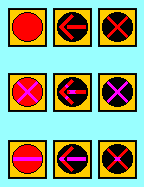
When lane use control (for reversible lanes) was first introduced, the signal displays were easily adapted to varying lane use. Only the circular red, yellow, and green, and the green arrow were in use. But as the MUTCD developed, it prohibited using the circular red for exclusively protected left turns, prohibited darkening a signal over an unused lane, and specified different signal faces for shared and exclusive turn lanes.
For many years, one of the following was done at signalized intersections within lane-use control:
New developments that will again allow moving indications with lane assignments include:

Only one more development is needed to make this possible: a triple aspect red signal. It is not essential, but makes assigning signal faces much easier.
There are three versions of this signal lens:

The lens has three aspects:
With LED technology, this special red section should be easy to make. It makes the following lane-use control system possible:
KEY:
Opposing Signals |
|
|
|
|
|---|---|---|---|---|
 |
1. BALANCED FLOW
|
|
|
|
2. BALANCED FLOW
|
|
|||
3. UNBALANCED 3 TO 2
|
|
Note that a permissive left turn across three or more lanes of oncoming traffic is not recommended. |
||
4. UNBALANCED 3 TO 2
|
|
Note that a permissive left turn across three or more lanes of oncoming traffic is not recommended. |
||
5. UNBALANCED 2 TO 1
|
|
Note that a permissive left turn from more than one lane is not recommended. A second signal face of thru indications is needed to meet MUTCD requirements. It would be to the right of the rightmost signal face shown, as seen by oncoming traffic. |
||
6. UNBALANCED 3 TO 1
|
|
Because a permissive left turn across three lanes is not recommended, the oncoming approach has no permissive left turn. A second signal face of thru indications is needed to meet MUTCD requirements. It would be to the right of the rightmost signal face shown, as seen by oncoming traffic. |
||
7. UNBALANCED 4 to 1
|
|
Note that a permissive left turn across three or more lanes of oncoming traffic is not recommended. A second signal face of thru indications is needed to meet MUTCD requirements. It would be to the right of the rightmost signal face shown, as seen by oncoming traffic. |
||
When the lane use is changed, the signal indications must change with the lane signals in a way to preserve safety.
|
The following sequence should be used when changing lane use.
The important part of this is to not send any vehicles in a lane into signals that are not ready for them. |

Animation Key:
|
What can be done before the FHWA allows a multiple aspect red section? The problem is twofold:
The difference between the circular red and the red arrow:
The difference between the other red indications and the red X

|
* The standard phrases in use violate the rules in English for placing the word "only," or lack clarity. The word "only" always modifies the word AFTER it (never the word before it). "Only" is NOT an adverb, so it does not follow the verb. The following table shows the wrong phrases, and their proper replacements: |
|
Links: